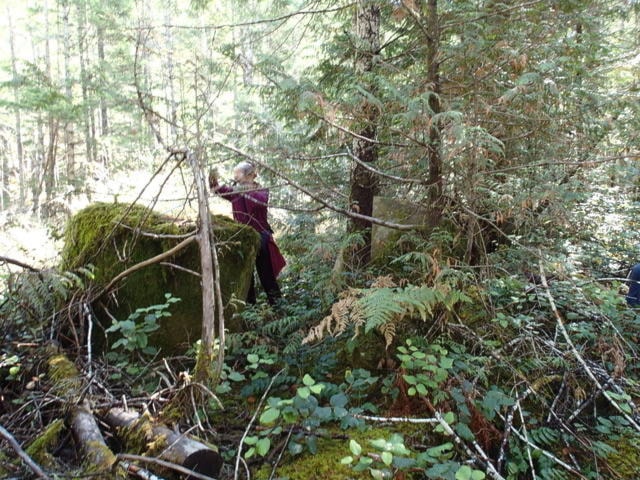Elida Peers | Contributed
We get lots of requests for help with history – some are relatively easy but this one was a challenge.
The first photo was sent by Rosemary Jorna, a hiker who particularly enjoys the Sooke hills, who noticed these strange stones and wondered what they were. Rosemary’s sister, Heather Phillips, is shown probing the centre of one of the stones.
Last week, led by the Capital Regional District’s Jim Bell, a group made a short expedition to look at the stones, which are located near the Galloping Goose Trail within the regional park. Pictured are Bruce Payne, Gary Schroyen, Doug MacFarlane, David Gibson, Heather Phillips, Adele Lewis, myself, and John McKenzie.
Sure enough, as soon as Doug MacFarlane saw the stones, he knew what they were – part of the consignment of items that Albert Yuen had bought from Labbatt Brewery Co. in downtown Victoria. These were millstones used in grinding the barley.
Back in 1982, when Yuen bought and began developing the area by Sooke River, the Potholes and beyond, property that had once been the home of George and Eileen Weiler, called Deer Trail, he had scrounged items that he hoped to re-use, as he worked towards developing his lodge of natural stone and old-growth timber.
If you had hiked along the Goose back in the 1980s you would have seen a series of large vats from Labatt that Yuen hoped to use for water storage, and stacked piles of old creosoted railway ties from the CNR line. Amongst the assorted equipment that came along from the closed brewery were two large rounded stones that have remained abandoned on site after the other items had been removed.
Though Yuen spent two decades working with his development plans, his lodge came to naught and by 2015 the area had become a CRD park.
Apparently the stones, which may have been imported from Britain, were used as millstones to grind barley and other grains in the production of beer.
Stones such as this were powered in the brewery to follow a circular pathway forcing the barley against another stone plate, cracking it to create the mash that would be cooked and set to ferment. It is thought that initially steam-powered generators were used to create the electricity to power these millstones.
Begun as Phoenix Brewery (c1890), then Labbatt, the brewery closed in 1980.
Nowadays, beer has not lost its popularity and we have several local breweries in Sooke. Their processes would differ greatly from the days when these millstones were used.
•••
Elida Peers is the historian of Sooke Region Museum.
editor@sookenewsmirror.com
Like us on Facebook and follow us on Twitter
